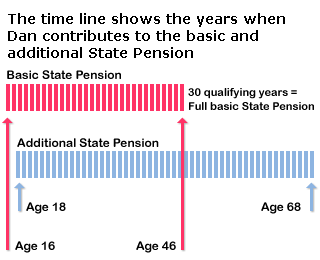 Go to main content
Go to main content
Archive Website of the UK government
Please note that this website has a UK government accesskeys system.
Main menu
Page menu
Pensions and retirement planning

Basic and additional State Pension
The State Pension is made up of two parts, the basic State Pension and the additional State Pension. People get different amounts of each. Find out what they are and who gets them.
The basic and additional State Pension
The full basic State Pension for a single person is £107.45 per week in 2012-13. Some people get more than this, because they get an additional State Pension on top of their basic State Pension.
Basic
Most people (but not everyone) get some basic State Pension, and the amount people gets varies. How much you get depends on the number of qualifying years you build up.
Additional
Some people also get additional State Pension. Whether you get it and how much you get depends on a number of things. This includes your National Insurance record and what you earn while you are working.
Contributions towards both parts of the State Pension
You may pay National Insurance contributions towards both the additional State Pension and basic State Pension.
If you reach State Pension age on or after 6 April 2010, you need 30 qualifying years to get a full basic State Pension. This means you don't build up any more basic State Pension entitlement. If you're working you have to carry on paying National Insurance contributions until you reach State Pension age. This applies even if you already have 30 years of contributions.
Unlike the basic State Pension, there is no cap on the number of years of National Insurance contributions towards the additional State Pension. You can keep contributing to the additional State Pension until you reach State Pension age. Once you reach State Pension age you stop paying National Insurance.
If you need more than 30 qualifying years
Some people need a minimum number of qualifying years to get any basic State Pension, for example:
- men born before 6 April 2023 usually need a minimum of 11 qualifying years to get any basic State Pension and 44 qualifying years to get a full basic State Pension
- women born before 6 April 2023 usually need a minimum of ten qualifying years to get any basic State Pension and 39 qualifying years to get a full basic State Pension
Example of contributing towards both parts of the State Pension
Dan starts getting qualifying years at 16, while he is in training. He starts work at 18 and is employed full-time until he reaches State Pension age, which for him is 68. He pays National Insurance for each year he is working which includes contributions towards the additional State Pension for each of these years. This means that:
- when Dan turns 46, he has 30 qualifying years, which means he has already contributed towards a full basic State Pension
- he continues to pay National Insurance until he reaches his State Pension age of 68 - this goes towards his additional State Pension and a range of other benefits that depend on National Insurance
- when he claims his State Pension, Dan has a full basic State Pension and an additional State Pension based on his contributions from age 18 to age 68.
Additional links
Simpler, Clearer, Faster

From 17 October, GOV.UK will be the best place to find government services and information

 Facebook
Facebook Twitter
Twitter StumbleUpon
StumbleUpon Delicious
Delicious Reddit
Reddit